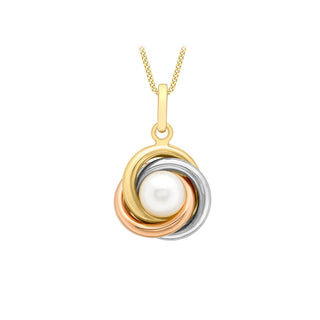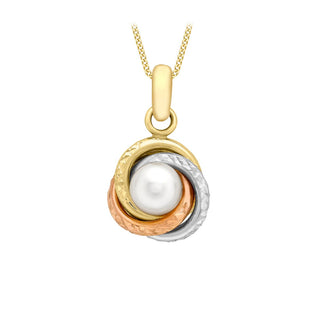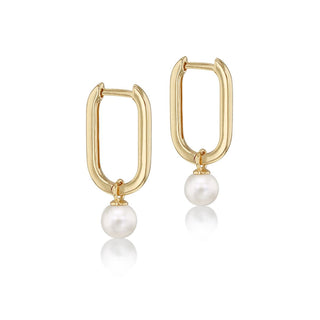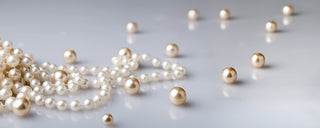
pearl jewellery guide
What are Pearls?
These lustrous beauties are the only gemstones created by living organisms. Formed inside certain mollusks, such as oysters and mussels, pearls are a result of a natural defence mechanism when an irritant, like a grain of sand, infiltrates the mollusk's shell. To protect itself, the mollusk secretes layers of nacre around the irritant, forming the pearl over time. Pearls come in various shapes, sizes, and colours, each with its unique charm. Common pearl shapes include round, oval, button, drop, and baroque. The colour spectrum ranges from classic white and cream to various shades of pink, peach, lavender, and even black. The shine of a pearl is determined by its lustre, which depends on the quality and thickness of the nacre layers.
Pearl Jewellery Inspiration
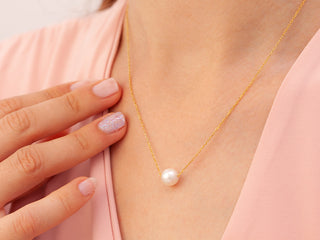
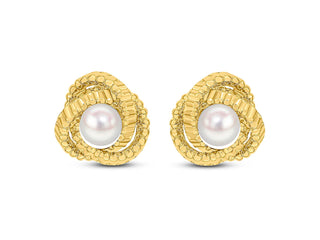
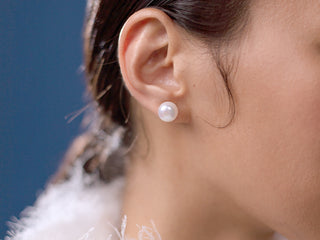
Pearl Lore and Meaning
Pearls have a deep-rooted history that transcends various cultures and time periods. Here are some key aspects of pearl lore and their symbolic significance:
- Symbol of Purity: Pearls have long been associated with purity and innocence. This association stems from the belief that pearls are formed when an irritant, such as a grain of sand, enters an oyster or mollusk and the creature coats it with layers of nacre to protect itself. This gradual process of forming a pearl symbolises the journey from impurity to beauty, much like a transformation from a simple irritant to a precious gem.
- Love and Marriage: Throughout history, pearls have been associated with love and marriage. In many cultures, pearls are considered symbols of enduring love and are often given as gifts on weddings and anniversaries. They are believed to enhance the bond between couples and bring harmony and happiness to relationships.
- Spiritual Significance: In various spiritual traditions, pearls hold symbolic significance. In Hinduism, pearls are associated with the moon and are believed to represent purity and wisdom. In Islamic tradition, pearls are considered a reward in paradise. Additionally, pearls have been used in traditional Chinese medicine for their purported healing properties and connection to spiritual energy.
- Symbol of Wisdom: Pearls have been linked to wisdom and knowledge in various cultures. The gradual and patient process of pearl formation is seen as a reflection of the wisdom gained through life's experiences.
The lore and meaning of pearls encompass a diverse range of symbols, including purity, love, wealth, spirituality, and wisdom. These lustrous gems have captured the imagination and admiration of humanity for centuries, and their enduring significance continues to make them treasured and meaningful gemstones to this day.
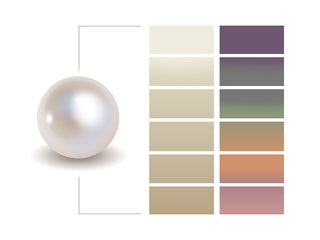
Pearl Jewellery Colour Guide
WHAT ARE THE BEST SHADES OF PEARL FOR JEWELLERY?
Pearls come in a variety of colours, and their hues can range from the traditional white to a stunning array of shades. The colour of a pearl is influenced by various factors, including the type of mollusk that produces it, the environment it grows in, and any impurities or pigments present during the pearl formation process.
Pearls come in various captivating colours, from classic white and dark Tahitian pearls to golden, pink, lavender, blue, peach, green, and silver hues. Each color carries its unique symbolism and charm, offering a range of choices to suit different styles and preferences. Whether you prefer the timeless elegance of white or the allure of rare lavender pearls, these lustrous gems continue to captivate jewellery enthusiasts worldwide.
Where do Pearls come from?

The most common type of pearl-producing mollusk is the oyster. Cultured pearls, which are the pearls commonly used in jewellery, are produced through a process called pearl farming. In pearl farming, a small bead or piece of mantle tissue from a donor oyster is surgically implanted into the host oyster. The oyster then begins to coat the implanted material with nacre, gradually forming a pearl over time.
Natural pearls, on the other hand, are formed without human intervention when an irritant accidentally enters the mollusk. However, natural pearls are exceedingly rare, and most pearls found in the market today are cultured pearls.
Cultured pearls are found in various regions around the world, where pearl farming has become a thriving industry. Some of the most renowned areas for pearl production include Japan, known for its classic Akoya pearls; China, a major player in freshwater and Akoya pearl cultivation; French Polynesia, particularly Tahiti, famous for its exquisite black Tahitian pearls; and Australia, which produces large and high-quality South Sea pearls in various shades. Additionally, Venezuela is emerging as a notable producer of freshwater pearls, and New Zealand has also made strides in the pearl farming sector, contributing to the diversity and beauty of cultured pearls found across the globe.
Types of Pearls
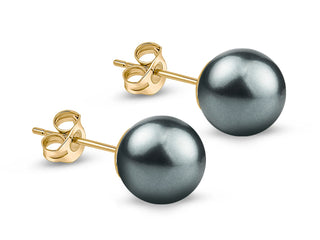
Tahitian Pearls
Tahitian pearls, often referred to as black pearls, are renowned for their striking and alluring beauty. Unlike the name suggests, they come in a mesmerising array of dark and iridescent colours, including various shades of grey, green, blue, and peacock hues. These pearls are produced by the black-lipped oyster, native to the pristine waters of French Polynesia, particularly around the islands of Tahiti.
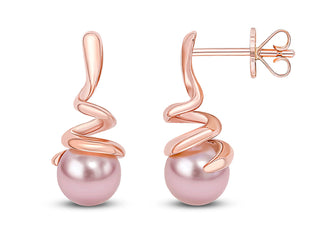
Pink Pearls
These lustrous gems come in various shades of pink, ranging from soft pastels to deeper rose tones, each possessing its unique allure. Pink pearls are typically formed by several types of mollusks, including freshwater mussels and certain saltwater oysters. Their gentle hue makes them a popular choice for creating elegant and romantic jewellery pieces, ideal for expressing sentiments of love and affection.
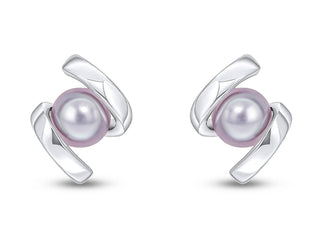
Grey Pearls
Grey pearls possess a captivating and sophisticated allure that sets them apart in the world of pearls. These alluring gems come in various shades of grey, ranging from light silver to deeper charcoal hues, with subtle overtones that can include hints of blue, green, or lavender. Grey pearls are produced by several species of mollusks, such as the Akoya oyster and the Tahitian black-lipped oyster.
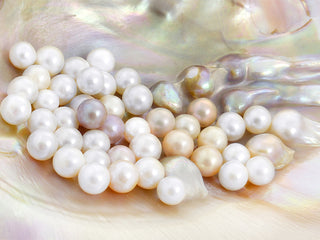
JUNE birthstone
Pearl Birthstone Jewellery
Pearl is one of the birthstones for the month of June. As the gemstone associated with this month, pearls hold special significance for individuals born during this time.
Pearls are often regarded as symbols of purity, innocence, and new beginnings, making them a fitting gemstone for those born in the month that marks the beginning of summer. Just as the summer season brings renewal and growth in nature, pearls are thought to represent the start of a new chapter in life for those celebrating their birthdays in June.
Famous Pearls
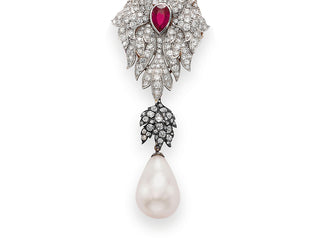
La Peregrina Pearl
The La Peregrina Pearl is one of the most famous and historically significant pearls in the world. Discovered off the coast of Panama in the 16th century, this large, pear-shaped pearl soon found its way into the hands of Spanish King Philip II. The pearl became a part of various European royal collections, passing through the hands of Spanish, French, and English royalty over the centuries. One of its most notable owners was actress Elizabeth Taylor, who received it as a gift from her husband, Richard Burton, in 1969.
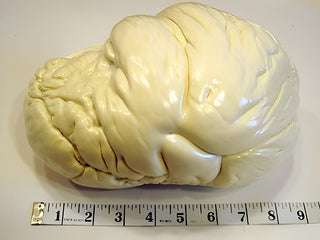
The Pearl of Allah
The Pearl of Allah, also known as the Pearl of Lao Tzu, is one of the largest and most valuable pearls ever discovered. It is a natural clam pearl that weighs an astounding 14 pounds (6.4 kg) and measures about 9.45 inches (24 cm) in diameter. Discovered off the coast of the Philippines in 1934, this unique and breathtaking pearl is believed to have formed inside a giant Tridacna gigas clam. Its impressive size and exceptional lustre have earned it the title of the "Pearl of Allah," symbolising its rarity and divine beauty.




